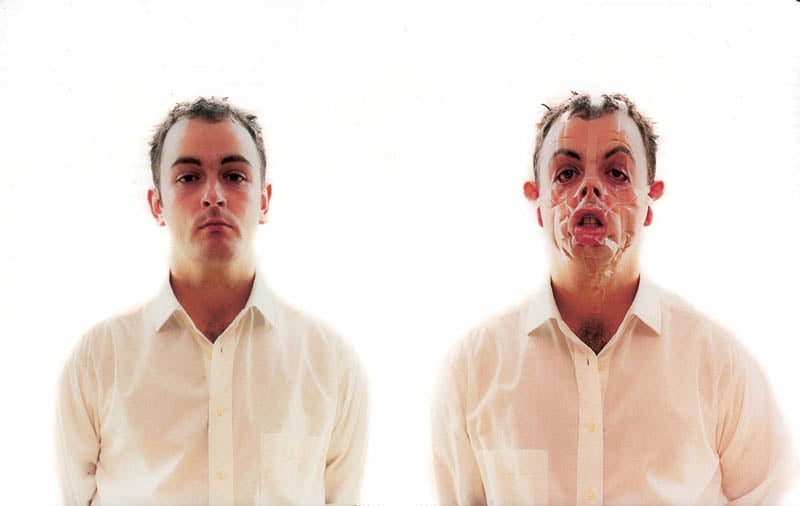
© » KADIST
Douglas Gordon
In Monster (1996-97), the artist’s face becomes grotesque through the application of strips of transparent adhesive tape, typical of Gordon’s performance-based films that often depict his own body in action. Also characteristic of his work, the scene takes place in front of a mirror, suggesting the kind of personal self-reflection that one is capable of – both good and evil. The video makes clear cinematographic reference to the ‘alter-ego’ transformation in Mamoulian’s Dr. Jekyll and Mr. Hyde, and to the “You looking at me?” sequence performed in front of a mirror by Robert De Niro in Scorsese’s Taxi Driver which also inspired Gordon’s through a looking glass ( 1999).

© » KADIST
Alessandro Balteo Yazbeck
Part of a larger series of photographic works, Alessandro Balteo Yazbeck’s Corrupted file from page 14 (V1) from the series La Vega, Plan Caracas No. 1, 1974-1976 presents an interrupted image. The images capture scenes from an urban development, La Vega, built to modernize and connect favelas in Venezuela.

© » KADIST
Jonathan Monk
Untitled (rolled up) , is an abstract portrait of Owen Monk, the artist’s father and features an aluminum ring of 56.6 cm in diameter measuring 1.77 cm in circumference, the size of his father. Jonathan Monk bridges a conceptual art and his family privacy, and ironically ensures that there is “no difference between Sol Lewitt and my mother, he does not know more than she do not know. ” What is the status of the O-backed chair rail to the white cube?

© » KADIST
Jonathan Monk
Drawing & Print (Drawing & Print)
Meeting #100 is one in a series of text works by Jonathan Monk. In this series, the artist attempts to organize meetings somewhere in the world. The audience is given the details of a meeting—the place, date and time—and nothing more.

© » KADIST
Ming Wong
Making Chinatown (2012) is a remake of Roman Polanski’s 1974 classic neo-noir film Chinatown . According to Wong, the latter is a “textbook” of Hollywood filmmaking . In Ming’s version, he plays all four main characters portrayed originally by Jack Nicholson, Faye Dunaway, John Huston, and Belinda Palmer, shooting against a backdrop of a film set reproduced as wallpaper in a gallery space.

© » KADIST
Danh Vo
The work “Les Fleurs d’intérieur” (which gives its name to the exhibiton presented at Kadist Art Foundation from May 30 to July 13, 2009) is a brass plate engraved with the inventory list of the works included in the show. From this moment, Dahn Vo will use this brass plates as a systematic element for all his exhibitions.

© » KADIST
Danh Vo
Good life (2007) is an installation displaying letters, documents, photographs and objects from a man named Joseph Carrier, and appropriated by artist Danh Vo. The installation features a series of small square vitrines, inset, dark and precisely spot-lit. Inside these are framed photographs, mostly black and white, of young Asian men, taken, as the titles on the neat brass name plates tell us, in Vietnam in the 1960s and early 1970s.

© » KADIST
Tacita Dean
The photographic quality of the film Baobab is not only the result of a highly sophisticated use of black and white and light, but also of the way in which each tree is characterized as an individual, creating in the end a series of portraits. The monumental and unnatural aspect of the baobabs turns them into strange and anthropomorphic personalities. Adding to the descriptive aspect of the film, the sound is a recording of the environment, of sounds made by animals, and participates in this peaceful contemplation.

© » KADIST
Gareth Moore
Uncertain Pilgrimage is an ongoing project in which Moore draws from his unplanned travels in recent years. Many of the pieces are found objects and discarded materials that he has transformed into tools and eccentric prop-like sculptures to help him on his journeys. Map (from Uncertain Pilgrimage) is one such object that could be a metaphor for the whole project: a simple empty paper map that has no location written on it.

© » KADIST
Oliver Laric
Oliver Laric’s video Versions is part of an ongoing body of work that has continued to evolve and mutate over time. Comprised of several video and sculptural works that share the same title, the Versions series reflects Laric’s key concerns: the mutability of images and objects and the negotiation between original and copy. In this video, we see several 3D renders of recognizable objects and places, while an ubiquitous feminized robotic voice that evokes the domestic familiarity of voice recognition tools such as Siri and Alexa, speaks of issues relating to identity, language, and translation.

© » KADIST
Douglas Gordon
Blind Spencer is part of the series “Blind Stars” including hundreds of works in which the artist cut out the eyes of Hollywood stars, in a symbolically violent manner. An emptiness (some are burned letting appear a white or mirror background or a mirror) replaces the eyes, giving the impression of a blind eye deprived of all expression. Paradoxically, the work looks at us all the more intensely.

© » KADIST
Anri Sala
Ghost Games , follows the enigmatic dance of crabs “steered” by a flashlight in the night of darkness of a South American beach. The video produces a surreal impression, typical of Sala’s work, with no plot in the classical sense, no story being told. Like in Blindfold (2002), in which a sunrise is reflected in urban billboards, and Time After Time (2001), in which the figure of a horse emerges from darkness lit by the headlights of an automobile, Sala likes to explore the phenomenon of light and its effects; In Ghost Games , he uses the threatening reflection of the flash light through the darkness of the beach.

© » KADIST
Douglas Gordon
Douglas Gordon’s single-channel video The Left Hand Can’t See That The Right Hand is Blind, captures an unfolding scene between two hands in leather gloves—at first seemingly comfortable to be entwined, and later, engaged in a struggle. As suggested by the work’s title, each of the hands assumes a character with a distinct personality, as if we were witnessing a lovers’ quarrel and embrace, or the embodiment of opposing forces of an internal struggle. Gordon has previously created performance-based works depicting his own body or parts of it—arms, hands, fingers, eyes—usually enacting simple, repetitive movements.

© » KADIST
Tino Sehgal
Tino Sehgal’s This Exhibition requires an interpreter (in this particular piece, a gallery attendant) to faux faint each and every time a visitor enters into a given space. Upon hitting the cold, hard gallery floor, the seemingly confused interpreter writhes slowly on the ground while reciting a few lines from the curatorial statement in a whispered moan.
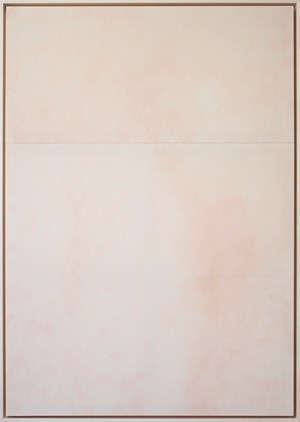
© » KADIST
Simon Fujiwara
Masks is a series of abstract paintings by Simon Fujiwara that together form a giant, fragmented portrait of German Chancellor Angela Merkel’s face. Masks (Merkel F6.1) was created in consultation with Merkel’s personal make-up artist; it features the special makeup that Merkel wears for HD cameras applied onto canvas. The image has been magnified to a near-microscopic level, rendering an ambiguous skin tone across which the makeup’s denser patches produce an abstract composition.

© » KADIST
Haegue Yang
A steel clothing rack adorned with turbine vents, Moroccan vintage jewelry, pinecones and knitting yarn, these heterogeneous elements are used here to create an exotic yet undefined identity within the work. Following Haegue Yang’s 2010 anthropomorphic series Medicine Men, this sculpture appears as a shamanic objet or being. It is mobile and can be activated.

© » KADIST
Haegue Yang
In addition to Yang’s signature drying rack and light bulbs, Office Voodoo includes various office supplies like CDs, paper clips, headphones, a computer mouse, a stamp, a hole puncher, a mobile phone charger. The installation suggests the personal, physical, psychological, and political dimensions of the modern office environment. Though abstracted from their original contexts, these materials are still formally recognizable and function as stand-ins for the places from which they came.

© » KADIST
Mariana Castillo Deball
Mariana Castillo Deball’s set of kill hole plates are part of a larger body of work problematizing archeological narratives, and drawing attention to the conservation process and its role in recreating an imagined object. They are playful and exaggerated representations of “kill hole pottery” — ceramic dishes in the Mimbres tradition with distinct circular holes located in the center of the pots. Although very little is known about the Mimbres culture’s specific beliefs, they are loosely understood to have terminated the object symbolically in preparation for funerary use.
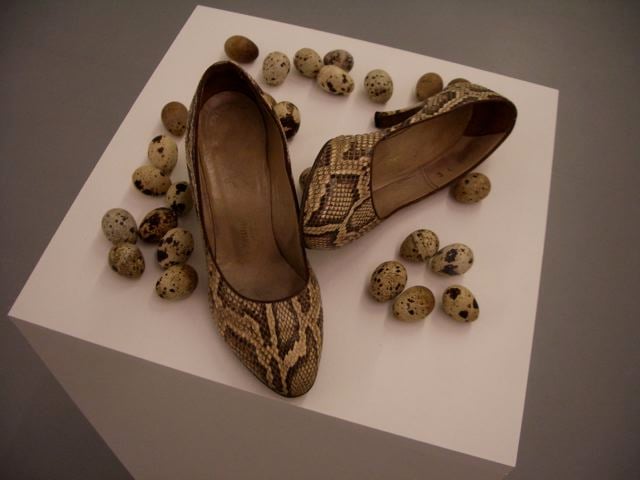
© » KADIST
Hans-Peter Feldmann
The types of objects Feldmann is interested in collecting into serial photographic grids or artist’s books are often also found in three dimensional installations. Verging on a form of fetichism, his shoe collections are a case in point and indeed, for some exhibitions, he even asked gallery employees for their shoes. Against authorship and the commodification of art, he never gives titles or dates to his works which have infinite edition possibilities.
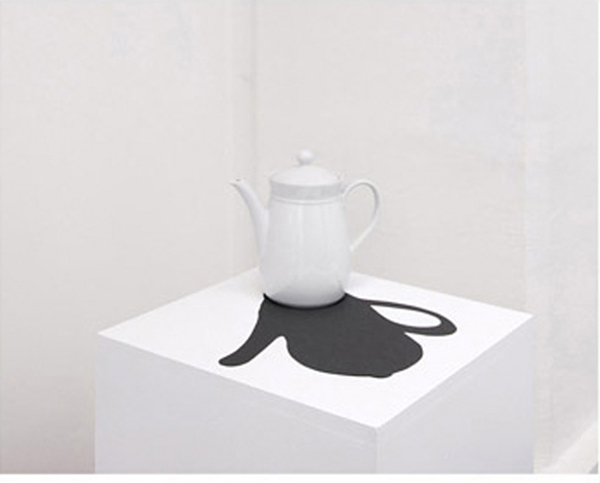
© » KADIST
Hans-Peter Feldmann
The types of objects Feldmann is interested in collecting into serial photographic grids or artist’s books are often also found in three dimensional installations. Against authorship and the commodification of art, he never gives titles or dates to his works which have infinite edition possibilities. This mise en scène of found kitchenware also exists with a rounder and flatter plain modern white porcelain teapot.
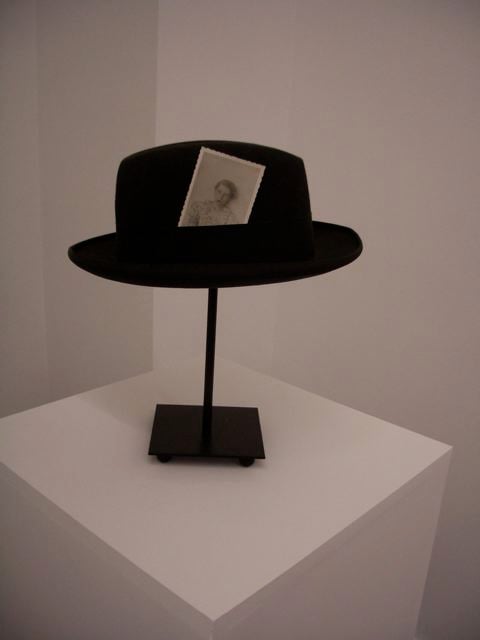
© » KADIST
Hans-Peter Feldmann
The types of objects Feldmann is interested in collecting into serial photographic grids or artist’s books are often also found in three dimensional installations. Hats and photographs are regularly part of his appropriations and arrangements. He famously made numerous trips to England in search of old photographs when he was an antique dealer, and then worked in a gift store with his wife when he left the art world in the 1980s.

© » KADIST
Mariana Castillo Deball
Do ut des (2009) is part of an ongoing series of books that Castillo Deball has altered with perforations, starting from the front page and working inward, forming symmetrical patterns when each spread is opened. The books belong to O Mundo dos Museus (The World of Museums), a collection conceived by the Brazilian designer Eugênio Hirsch in the 1970s. More than simply a catalogue of artworks, each offers the reader a promenade through a different world museum and its functioning, starting with photo reportage of the building, its urban landscape and architecture, the management and restoration of works, and visitors walking though the galleries.

© » KADIST
Wolfgang Tillmans
Wolfgang Tillmans initiated the ongoing series Faltenwurf in 1989, representing compositions of unused clothing, with special attention paid to the ways in which they drape and fold. The title is taken from a Germanic term used in the context of art history, designating classical drapery. In this particular photograph, Faltenwurf (Stairwell) , an assortment of various colored clothes lay tangled on a set of stairs, as a sculpture of abstract forms.

© » KADIST
Mariana Castillo Deball
Taking archaeology as her departure point to examine the trajectories of replicated and displaced objects, “Who will measure the space, who will tell me the time?” was produced in Oaxaca for her exhibition of the same title at the Contemporary Museum of Oaxaca (MACO) in 2015. The sculpture, employing the technique of traditional Atzompa pottery originating from Oaxaca, Mexico, is an examination of the way in which archaeological heritage is remembered in the earthenware made by Atzompa potters today. Accompanied by the publication ‘Ixiptla Vol.

© » KADIST
Judy Chicago
Domes #1 represents a significant moment in Chicago’s career when her art began to change from a New York-influenced Abstract Expressionist style to one that reflected the pop-inflected art being made in Los Angeles. By 1968, the year she began creating Domes , the twenty-nine-year-old artist had moved from Chicago to Los Angeles, graduated from UCLA, and was part of a generation of artists whose work was characterized by of the masculine overtones of Southern California’s flourishing car culture. Inspired by new technologies in the auto manufacturing, these “Finish Fetish” artists appropriated industrial materials such as car paint or lacquer to create artwork with pristine finishes.
Jonathan Monk
- location: Berlin, Germany
- year born: 1969
- gender: male
- nationality: British
- home town: Leicester, United Kingdom
Hans-Peter Feldmann
- location: Düsseldorf, Germany
- year born: 1941
- gender: male
- nationality: German
- home town: Dusseldorf, Germany
Mariana Castillo Deball
- location: Amsterdam & Berlin
- year born: 1975
- gender: female
- nationality: Mexican
- home town: Mexico City, Mexico
Douglas Gordon
- location: Berlin, Germany
- year born: 1966
- gender: male
- nationality: Scottish
- home town: Glasgow, United Kingdom
Haegue Yang
- location: Berlin, Germany & Seoul, South Korea
- year born: 1971
- gender: female
- nationality: Korean
- home town: Seoul, South Korea
Danh Vo
- location: Berlin, Germany
- year born: 1975
- gender: male
- nationality: Vietnamese and Danish
- home town: Ba Ria, Vietnam
Tacita Dean
- location: Berlin, Germany
- year born: 1965
- gender: female
- nationality: British
- home town: Canterbury, United Kingdom
Tino Sehgal
- location: Berlin, Germany
- year born: 1976
- gender: male
- nationality: British-German
- home town: London, United Kingdom
Ming Wong
- location: Berlin, Germany
- year born: 1971
- gender: male
- nationality: Singaporean
- home town: Singapore
Wolfgang Tillmans
- location: London & Berlin
- year born: 1968
- gender: male
- nationality: German
- home town: Remscheid, Germany
Judy Chicago
- location: Belen, New Mexico
- year born: 1939
- gender: female
- nationality: American
- home town: Chicago, Illinois
Anri Sala
- location: Berlin, Germany
- year born: 1974
- gender: male
- nationality: Albanian
- home town: Tirana, Albania
Simon Fujiwara
- location: Berlin, Germany
- year born: 1982
- gender: male
- nationality: British
Oliver Laric
- location: Berlin, Germany
- year born: 1981
- gender: male
- nationality: Austrian
- home town: Innsbruck, Austria
Alessandro Balteo Yazbeck
- location: Berlin, Germany
- year born: 1972
- gender: male
- nationality: Venezuelan
- home town: Caracas, Venezuela
Gareth Moore
- location: Berlin, Germany
- year born: 1975
- gender: male
- nationality: Canadian
- home town: Matsqui, Canada
-
1960-1969
Judy Chicago
1969Domes #1 represents a significant moment in Chicago’s career when her art began to change from a New York-influenced Abstract Expressionist style to one that reflected the pop-inflected art being made in Los Angeles...
-
1990-1999
Douglas Gordon
1996In Monster (1996-97), the artist’s face becomes grotesque through the application of strips of transparent adhesive tape, typical of Gordon’s performance-based films that often depict his own body in action...
-
2000-2009
Tacita Dean
2001The photographic quality of the film Baobab is not only the result of a highly sophisticated use of black and white and light, but also of the way in which each tree is characterized as an individual, creating in the end a series of portraits...
Douglas Gordon
2002Blind Spencer is part of the series “Blind Stars” including hundreds of works in which the artist cut out the eyes of Hollywood stars, in a symbolically violent manner...
Jonathan Monk
2003Untitled (rolled up) , is an abstract portrait of Owen Monk, the artist’s father and features an aluminum ring of 56.6 cm in diameter measuring 1.77 cm in circumference, the size of his father...
Douglas Gordon
2004Douglas Gordon’s single-channel video The Left Hand Can’t See That The Right Hand is Blind, captures an unfolding scene between two hands in leather gloves—at first seemingly comfortable to be entwined, and later, engaged in a struggle...
Tino Sehgal
2004Tino Sehgal’s This Exhibition requires an interpreter (in this particular piece, a gallery attendant) to faux faint each and every time a visitor enters into a given space...
Gareth Moore
2006Uncertain Pilgrimage is an ongoing project in which Moore draws from his unplanned travels in recent years...
Alessandro Balteo Yazbeck
2008Part of a larger series of photographic works, Alessandro Balteo Yazbeck’s Corrupted file from page 14 (V1) from the series La Vega, Plan Caracas No...
Mariana Castillo Deball
2009Do ut des (2009) is part of an ongoing series of books that Castillo Deball has altered with perforations, starting from the front page and working inward, forming symmetrical patterns when each spread is opened...
-
2010-2019
Haegue Yang
2010In addition to Yang’s signature drying rack and light bulbs, Office Voodoo includes various office supplies like CDs, paper clips, headphones, a computer mouse, a stamp, a hole puncher, a mobile phone charger...
Oliver Laric
2012Oliver Laric’s video Versions is part of an ongoing body of work that has continued to evolve and mutate over time...
Mariana Castillo Deball
2015Taking archaeology as her departure point to examine the trajectories of replicated and displaced objects, “Who will measure the space, who will tell me the time?” was produced in Oaxaca for her exhibition of the same title at the Contemporary Museum of Oaxaca (MACO) in 2015...
Simon Fujiwara
2016Masks is a series of abstract paintings by Simon Fujiwara that together form a giant, fragmented portrait of German Chancellor Angela Merkel’s face...
Haegue Yang
2016A steel clothing rack adorned with turbine vents, Moroccan vintage jewelry, pinecones and knitting yarn, these heterogeneous elements are used here to create an exotic yet undefined identity within the work...
Wolfgang Tillmans
2017Wolfgang Tillmans initiated the ongoing series Faltenwurf in 1989, representing compositions of unused clothing, with special attention paid to the ways in which they drape and fold...


